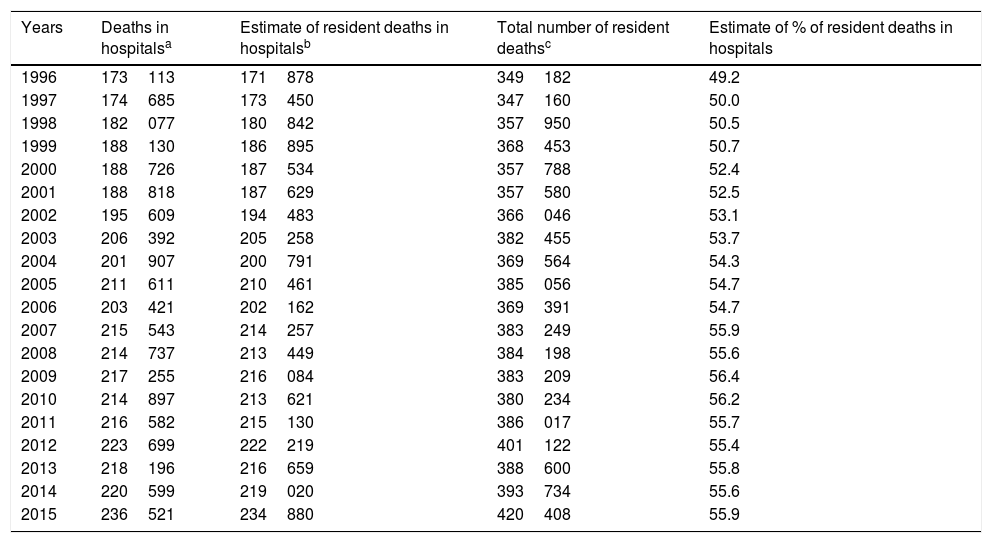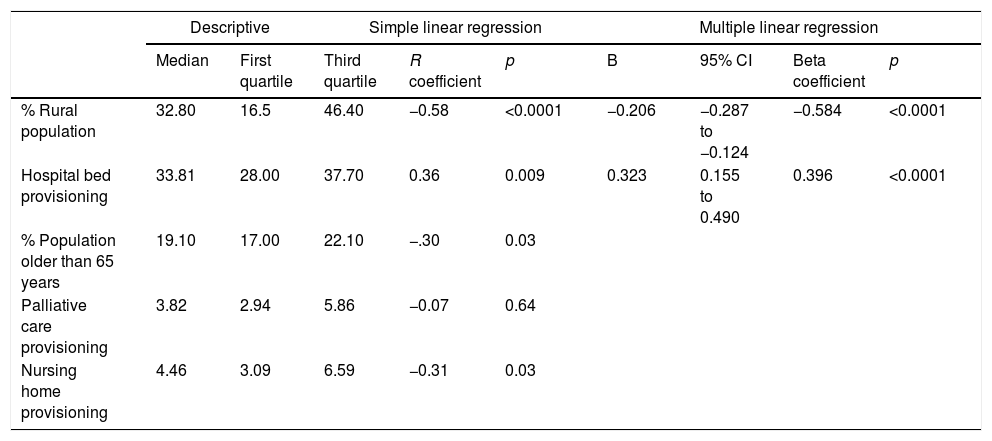The location where death occurs varies widely among societies. The aim of this study was to describe the evolution in the hospital mortality rate (HMR) in Spain over the course of 20years and its distribution by province during a more recent period and to explore its relationship with potential explanatory variables.
MethodsThis was an ecological study. The population mortality rates were obtained from the Natural Population Movement (Movimiento Natural de la Población), and the hospital mortality rates were obtained from the Specialized Care Information System (Sistema de Información en Atención Especializada), which includes information from all hospitals in Spain. We calculated the mortality rates for patients who were not surveyed and the HMR at the national level between 1996 and 2015 and for provinces between 2013 and 2015. The relationship between the provincial distribution of HMR and various demographic, socioeconomic and healthcare variables were analyzed through simple and multiple linear regressions.
ResultsThe HMR in Spain increased from 49% in 1996 to 56% in 2007, having remained stable from 1996 to 2015. The variation among provinces was 40–70%. The multivariate analysis showed a higher HMR in the less rural provinces and in those with a larger availability of hospital beds.
ConclusionsThere is considerable provincial heterogeneity in Spain in terms of the probability of dying in hospital or at home. This result could be partly explained by demographics (percentage of rural population) and the healthcare structure (number of hospital beds per population).
El lugar en que se produce la muerte varía ampliamente en las distintas sociedades. El objetivo del estudio fue describir la evolución del porcentaje de muertes en hospitales (PMH) en España a lo largo de 20años, así como su distribución por provincias en un periodo más reciente y explorar su relación con posibles variables explicativas.
MétodosEl estudio fue ecológico. Las muertes poblacionales se obtuvieron del Movimiento Natural de la Población, y las muertes en hospitales, del Sistema de Información en Atención Especializada, que incluye información de todos los hospitales del país. Se estimaron las muertes de pacientes no censados y se calculó el PMH a nivel nacional entre 1996 y 2015 y por provincias entre 2013 y 2015. La relación entre la distribución provincial del PMH y diversas variables de tipo demográfico, socioeconómico y asistencial se analizó mediante regresión lineal simple y múltiple.
ResultadosEl PMH ascendió en España desde el 49% en 1996 hasta el 56% en 2007, habiendo permanecido estable desde entonces hasta 2015. Su variación entre provincias fue del 40 al 70%. El análisis multivariante mostró un PMH superior en las provincias menos rurales y en aquellas con mayor dotación de camas hospitalarias.
ConclusionesEn España existe una gran heterogeneidad provincial en cuanto a la probabilidad de morir en un hospital o en el domicilio. Esto se justifica en parte por razones sociodemográficas (porcentaje de población rural) y de la estructura sanitaria (número de camas hospitalarias por población).
Article
Diríjase desde aquí a la web de la >>>FESEMI<<< e inicie sesión mediante el formulario que se encuentra en la barra superior, pulsando sobre el candado.

Una vez autentificado, en la misma web de FESEMI, en el menú superior, elija la opción deseada.

>>>FESEMI<<<










